2015 MERCEDES-BENZ E-CLASS ESTATE airbag off
[x] Cancel search: airbag offPage 7 of 497
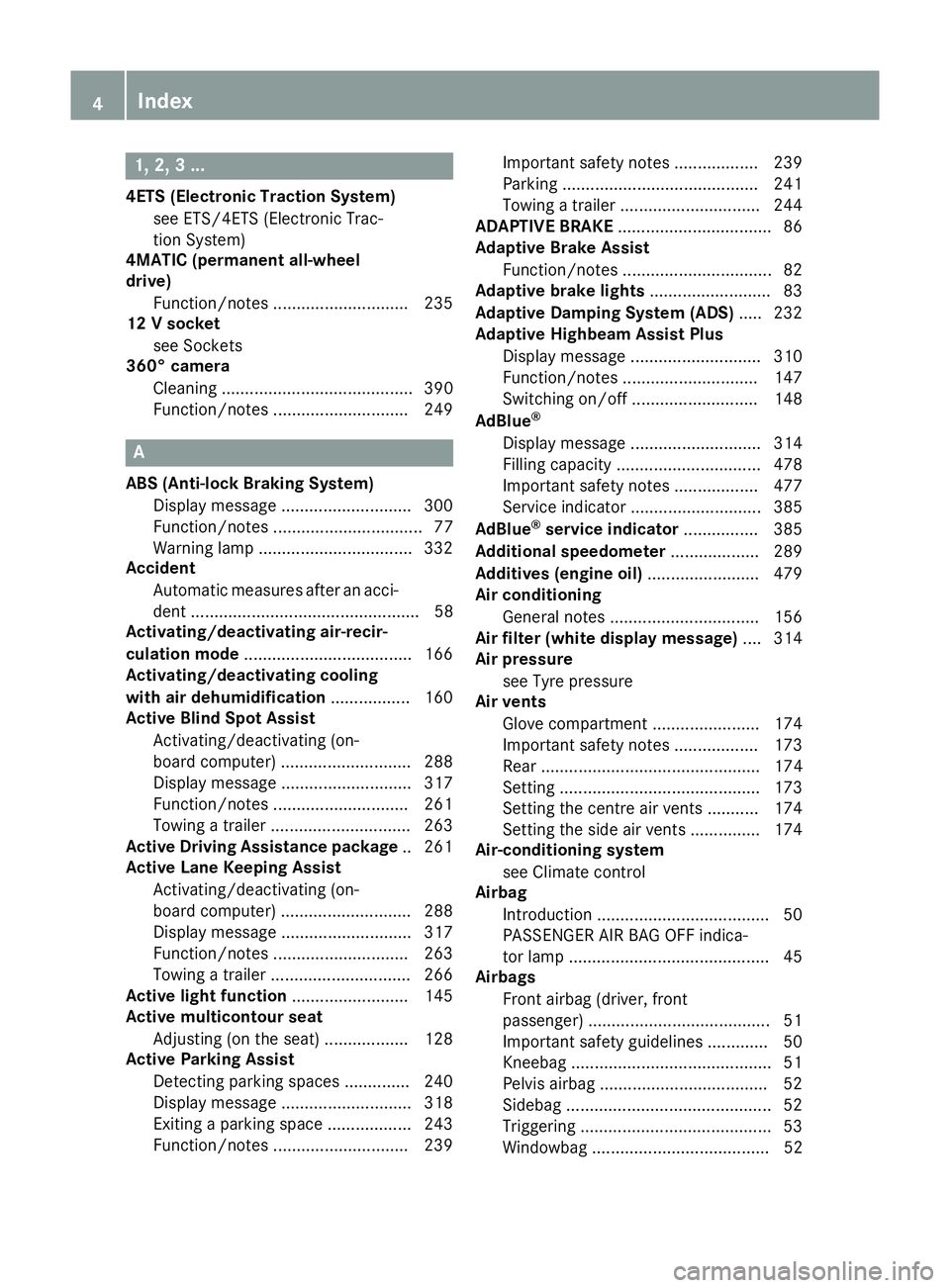
1, 2,
3...
4ETS (Electronic Traction System) see ETS/4ETS (Electronic Trac-
tion System)
4MATIC (permanent all-wheel
drive)
Function/notes .............................2 35
12 Vsocket
see Sockets
360 °camera
Cleaning ......................................... 390
Function/notes ............................ .249 A
ABS (Anti-lock Braking System) Display message ............................ 300
Function/notes ................................ 77
Warning lamp ................................. 332
Accident
Automatic measure safter an acci-
dent ................................................. 58
Activating/deactivating air-recir-
culation mode ................................... .166
Activating/deactivating cooling
with air dehumidification ................. 160
Active Blin dSpot Assist
Activating/deactivating (on-
board computer) ............................ 288
Display message ............................ 317
Function/notes ............................ .261
Towing atrailer .............................. 263
Active Driving Assistanc epackage .. 261
Active Lane Keepin gAssist
Activating/deactivating (on-
board computer) ............................ 288
Display message ............................ 317
Function/notes ............................ .263
Towing atrailer .............................. 266
Active light function ......................... 145
Active multicontour seat
Adjusting (on the seat) .................. 128
Active Parking Assist
Detecting parking spaces .............. 240
Display message ............................ 318
Exiting aparking space .................. 243
Function/notes ............................ .239 Important safety notes .................. 239
Parking .......................................... 241
Towing atrailer .............................. 244
ADAPTIVE BRAKE ................................. 86
Adaptive Brake Assist
Function/notes ................................ 82
Adaptive brake lights .......................... 83
Adaptive Dampin gSyste m(ADS)..... 232
Adaptive Highbeam Assist Plus
Display message ............................ 310
Function/notes ............................ .147
Switching on/off ........................... 148
AdBlue ®
Display message ............................ 314
Filling capacity ............................... 478
Important safety notes .................. 477
Service indicator ............................ 385
AdBlue ®
service indicator ................ 385
Additional speedometer ................... 289
Additives (engine oil) ........................ 479
Airc onditioning
General notes ................................ 156
Airf ilter(wh ite display message) .... 314
Airp ressure
see Tyr epressure
Airv ents
Glove compartment ....................... 174
Important safety notes .................. 173
Rea r............................................... 174
Setting .......................................... .173
Setting the centre airv ents ........... 174
Setting the sid eairvents .............. .174
Air-conditionin gsystem
see Climate control
Airbag
Introduction ..................................... 50
PASSENGER AIR BAG OFF indica-
tor lamp .......................................... .45
Airbags
Fron tairbag (driver ,front
passenger )....................................... 51
Important safety guidelines .............50
Kneebag ........................................... 51
Pelvi sairbag .................................... 52
Sideba g............................................ 52
Triggering .........................................53
Windowbag ...................................... 52 4
Index
Page 27 of 497
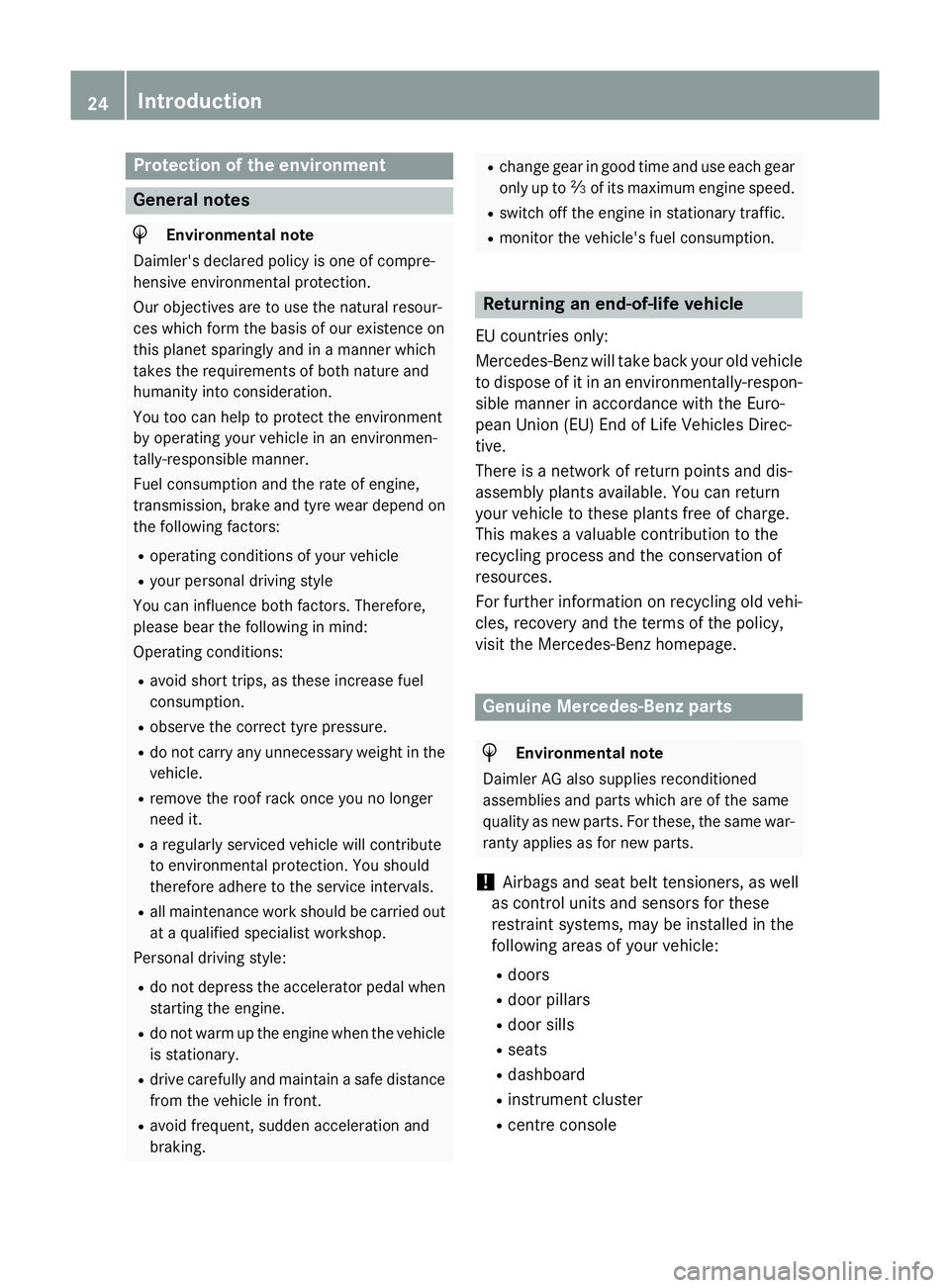
Protection of the environment
General notes
H
Environmental note
Daimler's declared policy is one of compre-
hensive environmental protection.
Our objectives are to use the natural resour-
ces which form the basis of our existence on
this planet sparingly and in amanner which
takes the requirements of both nature and
humanity into consideration.
You too can help to protect the environment
by operating your vehicle in an environmen-
tally-responsible manner.
Fuel consumption and the rate of engine,
transmission, brake and tyre wear depend on
the following factors:
R operating condition sofyour vehicle
R your personal driving style
You can influence both factors. Therefore,
please bear the following in mind:
Operating conditions:
R avoid short trips, as these increase fuel
consumption.
R observe the correct tyre pressure.
R do not carry any unnecessary weight in the
vehicle.
R remove the roof rack once you no longer
need it.
R ar egularly serviced vehicle will contribute
to environmental protection. You should
therefore adhere to the service intervals.
R all maintenance work should be carried out
at aq ualified specialist workshop.
Personal driving style:
R do not depress the accelerator pedal when
startingt he engine.
R do not warm up the engine when the vehicle
is stationary.
R drive carefully and maintain asafe distance
from the vehicle in front.
R avoid frequent, sudden acceleration and
braking. R
change gear in good time and use each gear
only up to Ôof its maximum engine speed.
R switch off the engine in stationary traffic.
R monitor the vehicle's fuel consumption. Returning an end-of-life vehicle
EU countries only:
Mercedes-Benz will take back your old vehicle to dispose of it in an environmentally-respon-sible manner in accordance with the Euro-
pean Union (EU) End of Life Vehicles Direc-
tive.
There is anetwork of return points and dis-
assembly plants available. You can return
your vehicle to these plants free of charge.
This makes avaluable contribution to the
recycling process and the conservation of
resources.
For further information on recycling old vehi- cles, recovery and the terms of the policy,
visit the Mercedes-Benz homepage. Genuine Mercedes-Benz parts
H
Environmental note
Daimler AG also suppliesr econditioned
assemblies and parts which are of the same
quality as new parts. For these, the same war-
ranty appliesasf or new parts.
! Airbags and seat belt tensioners, as well
as control units and sensors for these
restraint systems, may be installed in the
following areas of your vehicle:
R doors
R door pillars
R door sills
R seats
R dashboard
R instrumen tcluster
R centre console 24
Introduction
Page 47 of 497
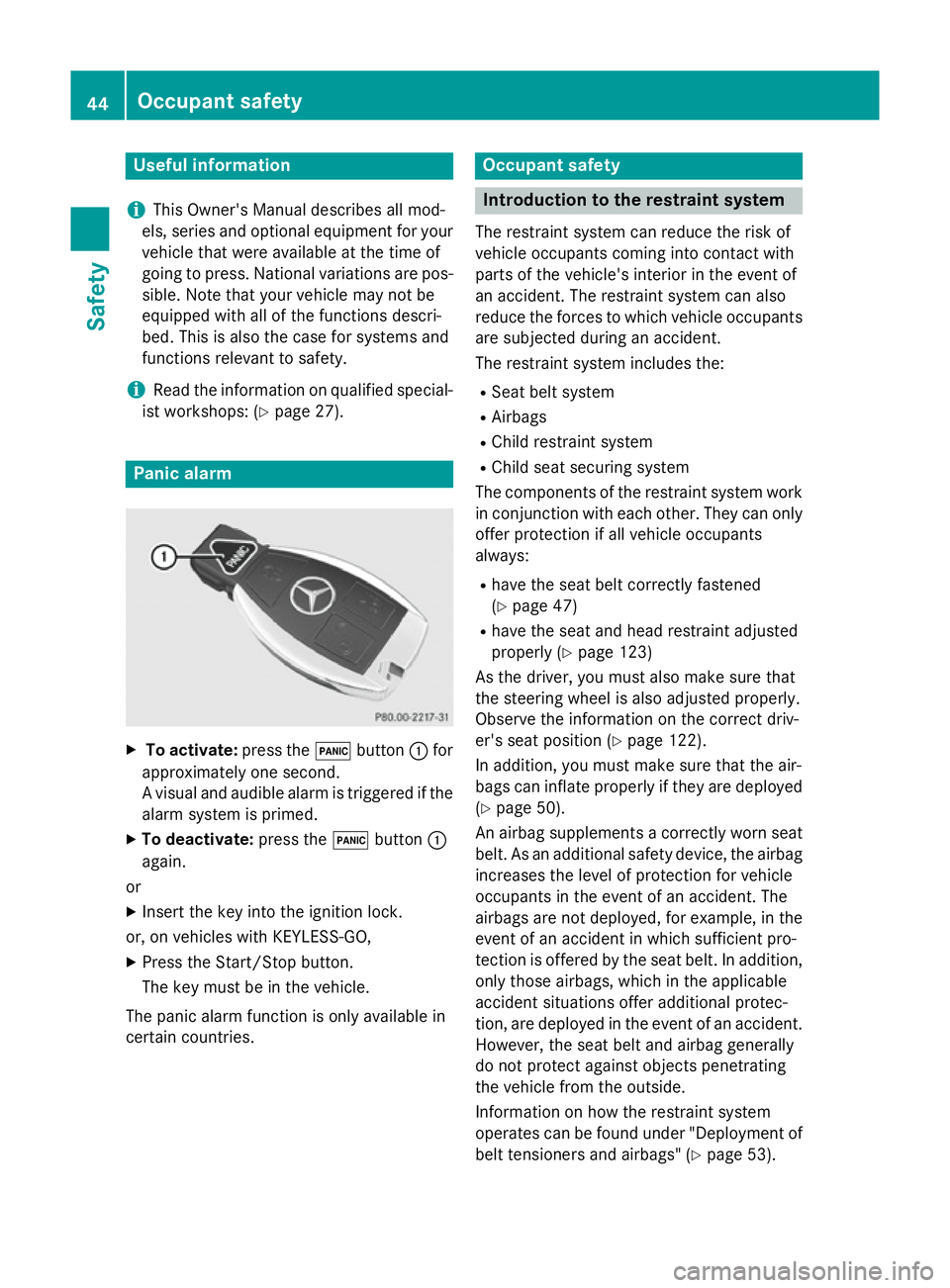
Useful information
i This Owner's Manual describes all mod-
els, series and optional equipment for your
vehicle that were available at the time of
going to press. National variation sare pos-
sible. Not ethat your vehicle may not be
equipped with all of the function sdescri-
bed. This is also the case for system sand
function srelevan ttosafety.
i Read the information on qualified special-
ist workshops: (Y page 27). Panic alarm
X
To activate: press the!button :for
approximately one second.
Av isual and audible alarm is triggered if the
alarm system is primed.
X To deactivate: press the!button :
again.
or X Insert the key int othe ignition lock.
or, on vehicles with KEYLESS‑GO, X Press the Start/Stop button.
The key must be in the vehicle.
The panic alarm function is only available in
certain countries. Occupant safety
Introduction to the restraint system
The restraint system can reduce the risk of
vehicle occupants comin gintoc ontact with
parts of the vehicle' sinterior in the even tof
an accident. The restraint system can also
reduce the forces to which vehicle occupants
are subjected during an accident.
The restraint system includes the:
R Seat belt system
R Airbags
R Child restraint system
R Child seat securin gsystem
The components of the restraint system work
in conjunction with each other .They can only
offer protection if all vehicle occupants
always:
R have the seat belt correctly fastened
(Y page 47)
R have the seat and head restraint adjusted
properly (Y page 123)
As the driver, you must also make sure that
the steering wheel is also adjusted properly.
Observ ethe information on the correct driv-
er's seat position (Y page 122).
In addition ,you must make sure that the air-
bags can inflat eproperly if they are deployed
(Y page 50).
An airbag supplement sacorrectly worn seat
belt. As an additional safet ydevice, the airbag
increases the level of protection for vehicle
occupants in the even tofanaccident. The
airbags are not deployed, for example, in the even tofana ccidentinwhich sufficient pro-
tection is offered by the seat belt. In addition,
only thos eairbags, which in the applicable
acciden tsituation soffer additional protec-
tion ,are deployed in the even tofanaccident.
However ,the seat belt and airbag generally
do not protect against objects penetrating
the vehicle from the outside.
Information on how the restraint system
operates can be found under "Deploymen tof
belt tensioner sand airbags" (Y page 53).44
Occupant safetySafety
Page 48 of 497
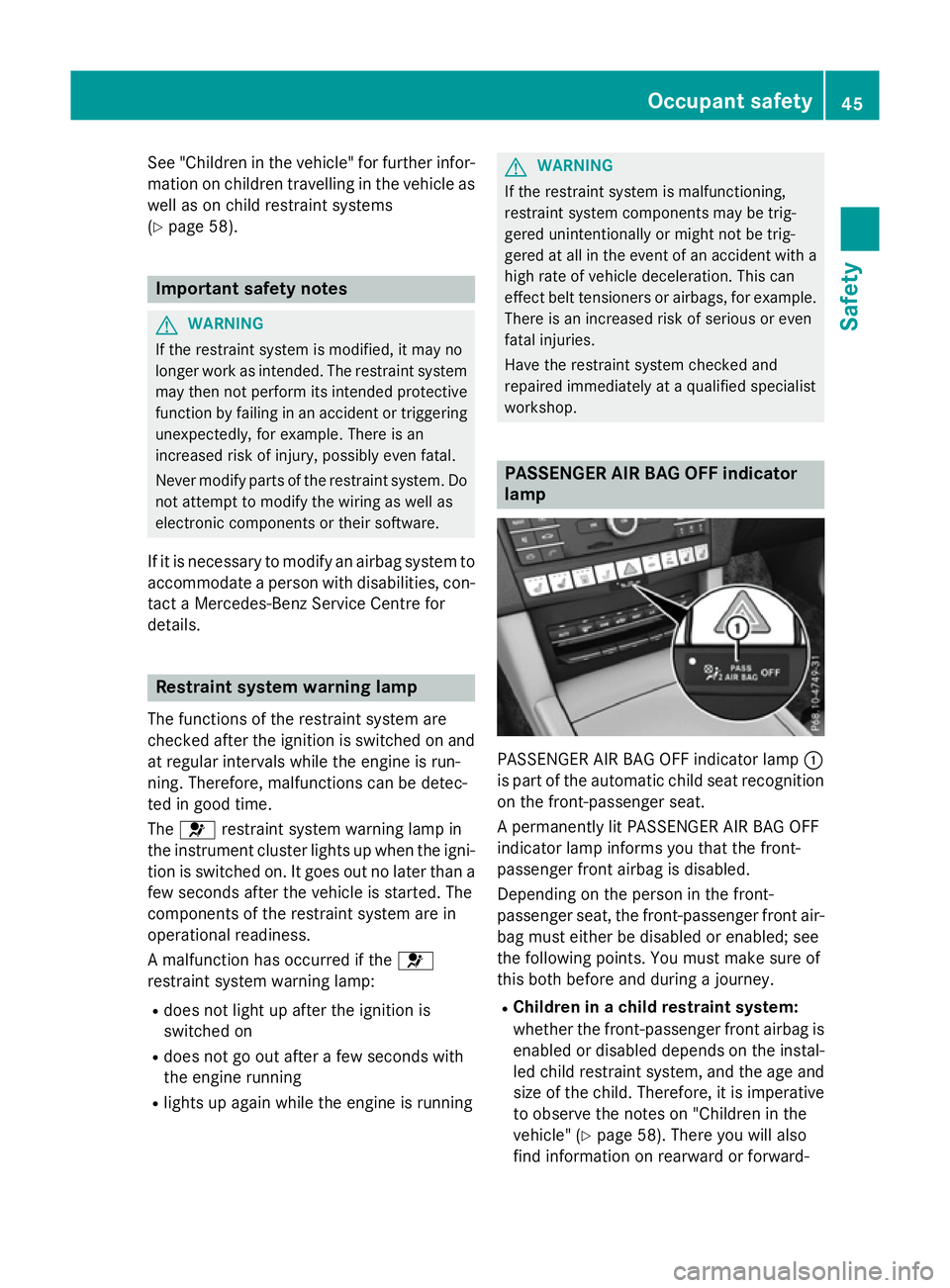
See "Children in the vehicle" for further infor-
mation on children travelling in the vehicl eas
well as on child restraint systems
(Y page 58). Important safety notes
G
WARNING
If the restraint system is modified ,itmay no
longer work as intended .The restraint system
may then not perfor mits intended protective
function by failing in an accident or triggering
unexpectedly, for example. There is an
increased ris kofinjury ,possibly eve nfatal.
Neve rmodify parts of the restraint system. Do
not attempt to modify the wiring as well as
electronic components or thei rsoftware.
If it is necessary to modify an airba gsystem to
accommodate aperson with disabilities, con-
tact aMercedes-Benz Service Centre for
details. Restrain
tsystem warnin glamp
The functions of the restraint system are
checke dafterthe ignition is switche donand
at regular interval swhile the engine is run-
ning. Therefore, malfunctions can be detec-
ted in goo dtime.
The 6 restraint system warning lamp in
the instrument cluster lights up when the igni- tion is switche don. It goe soutno later tha na
few seconds afte rthe vehicl eisstarted. The
components of the restraint system are in
operationa lreadiness.
Am alfunction ha soccurred if the 6
restraint system warning lamp:
R doe snot light up afte rthe ignition is
switche don
R doe snot go ou tafte raf ew seconds with
the engine running
R lights up agai nwhile the engine is running G
WARNING
If the restraint system is malfunctioning,
restraint system components may be trig-
gered unintentionally or might not be trig-
gered at al linthe event of an accident with a
high rate of vehicl edeceleration. Thi scan
effect belt tensioner sorairbags, for example.
There is an increased ris kofserious or even
fata linjuries.
Hav ethe restraint system checke dand
repaired immediatel yataqualified specialist
workshop. PASSENGER AI
RBAG OF Find icator
lamp PASSENGER AIR BAG OFF indicator lamp
:
is part of the automatic child sea trecognition
on the front-passenger seat.
Ap ermanently li tPASSENGER AIR BAG OFF
indicator lamp informs yo uthatthe front-
passenger front airba gisdisabled.
Depending on the person in the front-
passenger seat, the front-passenger front air-
ba gm uste ither be disabled or enabled ;see
the following points. Yo umustm ake sure of
this both before and during ajourney.
R Childre ninachild restrain tsystem:
whethe rthe front-passenger front airba gis
enabled or disabled depends on the instal- le dc hild restraint system, and the ag eand
size of the child .Therefore, it is imperative
to observe the notes on "Children in the
vehicle" (Y page 58). There yo uwilla lso
find information on rearward or forward- Occupant safety
45Safety Z
Page 49 of 497
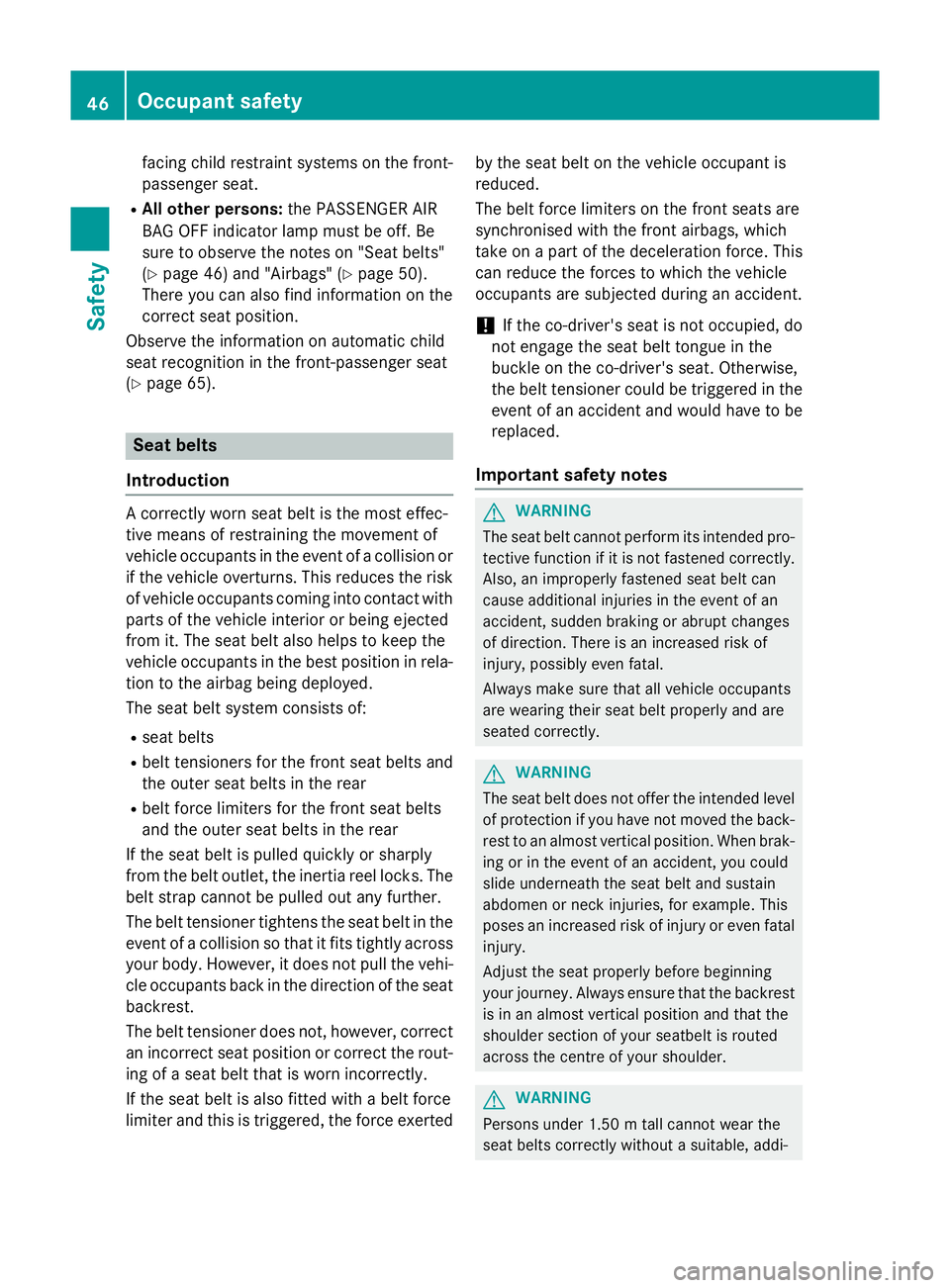
facing child restraint systems on the front-
passenger seat.
R Allo ther persons: the PASSENGER AIR
BAG OFF indicator lamp must be off. Be
sure to observe the notes on "Sea tbelts"
(Y pag e46) and "Airbags "(Ypag e50).
There you can also find information on the
correct sea tposition.
Observe the information on automatic child
sea trecognition in the front-passenger seat
(Y pag e65). Seat belts
Introduction Ac
orrectly worn sea tbeltist he most effec-
tive means of restraining the movement of
vehicle occupants in the event of acollision or
if the vehicle overturns. This reduces the risk
of vehicle occupants coming into contact with
parts of the vehicle interio rorbeing ejected
from it. The sea tbelta lsoh elpstok eep the
vehicle occupants in the best position in rela- tion to the airbag being deployed.
The sea tbelts ystem consists of:
R sea tbelts
R bel ttensioners for the front sea tbelts and
the outer sea tbelts in the rear
R bel tforce limiters for the front sea tbelts
and the outer sea tbelts in the rear
If the sea tbeltisp ulled quickly or sharply
from the bel toutlet, the inertia reel locks. The
bel tstrap cannot be pulled out any further.
The bel ttensioner tightens the sea tbeltint he
event of acollision so that it fits tightly across
you rbody .However, it does not pul lthe vehi-
cle occupants back in the direction of the seat backrest.
The bel ttensioner does not, however, correct
an incorrect sea tposition or correct the rout-
ing of aseatb eltt hat is worn incorrectly.
If the sea tbeltisa lsof itted with abeltf orce
limiter and this is triggered, the force exerted by the sea
tbeltont he vehicle occupant is
reduced.
The bel tforce limiters on the front seats are
synchronised with the front airbags, which
take on apart of the deceleration force. This
can reduce the forces to which the vehicle
occupants are subjected during an accident.
! If the co-driver's sea
tisnot occupied, do
not engag ethe sea tbeltt ongue in the
buckle on the co-driver's seat. Otherwise,
the bel ttensioner coul dbetriggered in the
event of an accident and would have to be
replaced.
Important safety notes G
WARNING
The sea tbeltc annot perform its intended pro-
tective function if it is not fastened correctly. Also, an improperl yfastened sea tbeltc an
caus eadditiona linjuries in the event of an
accident, sudden braking or abrupt changes
of direction. There is an increased risk of
injury ,possibly even fatal.
Always make sure that all vehicle occupants
are wearing their sea tbeltp roperly and are
seated correctly. G
WARNING
The sea tbeltd oes not offer the intended level
of protection if you have not moved the back-
rest to an almost vertical position. When brak-
ing or in the event of an accident, you could
slide underneath the sea tbelta nd sustain
abdomen or neck injuries, for example. This
pose sani ncreased risk of injury or even fatal
injury.
Adjust the sea tproperly before beginning
you rjourney .Always ensure that the backrest
is in an almost vertical position and that the
shoulde rsection of you rseatbelt is routed
across the centre of you rshoulder. G
WARNING
Persons unde r1.50 mtallc annot wear the
seat belts correctl ywithou tas uitable, addi- 46
Occupant safetySafety
Page 53 of 497
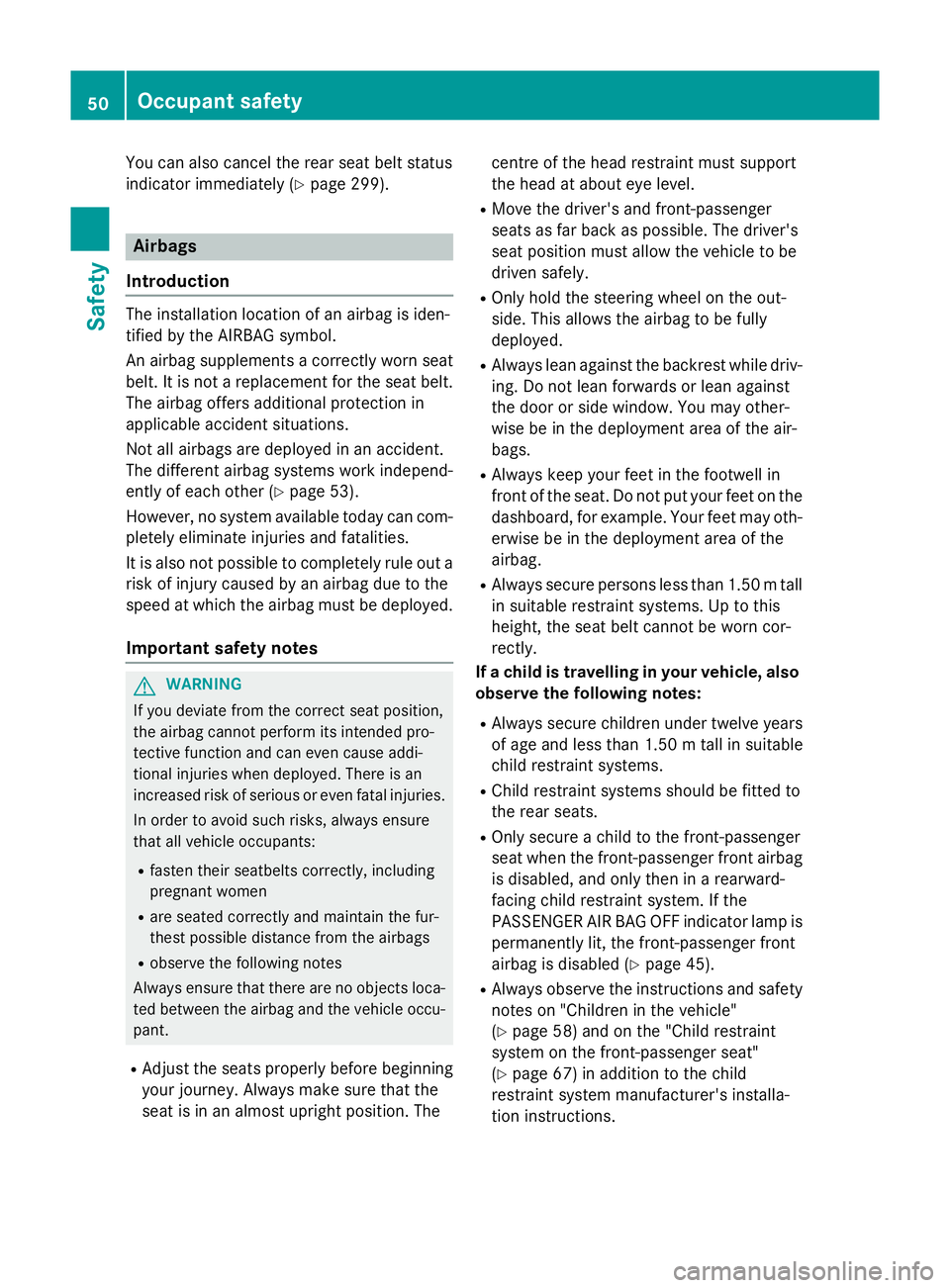
You can also cancel the rear seat belt status
indicator immediately (Y page 299).Airbags
Introduction The installation location of an airbag is iden-
tified by the AIRBA Gsymbol.
An airbag supplements acorrectly worn seat
belt. It is not areplacemen tfor the seat belt.
The airbag offers additional protection in
applicable accident situations.
Not all airbags are deployed in an accident.
The differen tairbag systems work independ-
ently of each other (Y page 53).
However, no system available today can com- pletely eliminate injuries and fatalities.
It is also not possible to completely rule out a
risk of injury caused by an airbag due to the
speed at which the airbag must be deployed.
Important safet ynotes G
WARNING
If you deviat efromt he correc tseat position,
the airbag cannot perform its intended pro-
tectiv efunction and can even cause addi-
tional injuries when deployed. There is an
increased risk of serious or even fatal injuries.
In order to avoid such risks, always ensure
that all vehicle occupants:
R fasten their seatbelts correctly, including
pregnant women
R are seate dcorrectly and maintain the fur-
thest possible distanc efromt he airbags
R observe the followin gnotes
Always ensure that there are no object sloca-
ted betwee nthe airbag and the vehicle occu-
pant.
R Adjust the seats properly befor ebeginning
your journey. Always make sure that the
seat is in an almost upright position. The centr
eofthe head restraint must support
the head at about eye level.
R Move the driver's and front-passenger
seats as far back as possible. The driver's
seat position must allow the vehicle to be
drive nsafely.
R Only hold the steerin gwheel on the out-
side. This allows the airbag to be fully
deployed.
R Always lean against the backrest while driv-
ing. Do not lean forwards or lean against
the door or side window. You may other-
wise be in the deploymen tarea of the air-
bags.
R Always keep your feet in the footwell in
front of the seat. Do not put your feet on the
dashboard ,for example. Your feet may oth-
erwise be in the deploymen tarea of the
airbag.
R Always secur epersons less than 1.50 mtall
in suitable restraint systems .Uptothis
height ,the seat belt canno tbeworn cor-
rectly.
If ac hild is travelling in you rvehicle, also
observe th efollowing notes:
R Always secure childre nunde rtwelve years
of age and less than 1.50 mtall in suitable
child restraint systems.
R Child restraint systems should be fitte dto
th er ear seats.
R Only secure achild to th efront-pa ssenger
seat when th efront-pa ssenger fron tairbag
is disabled, and only then in arearward-
facing child restraint system. If the
PASSENGER AI RBAG OFFindicator lamp is
permanently lit ,the front-passenger front
airbag is disabled (Y page 45).
R Always observ ethe instruction sand safety
note son" Children in th evehicle"
(Y page 58) and on th e"Child restraint
system on th efront-pa ssenger seat"
(Y page 67 )inaddition to th echild
restraint system manufacturer' sinstalla-
tio ninstructions. 50
Occupant safetySafety
Page 54 of 497
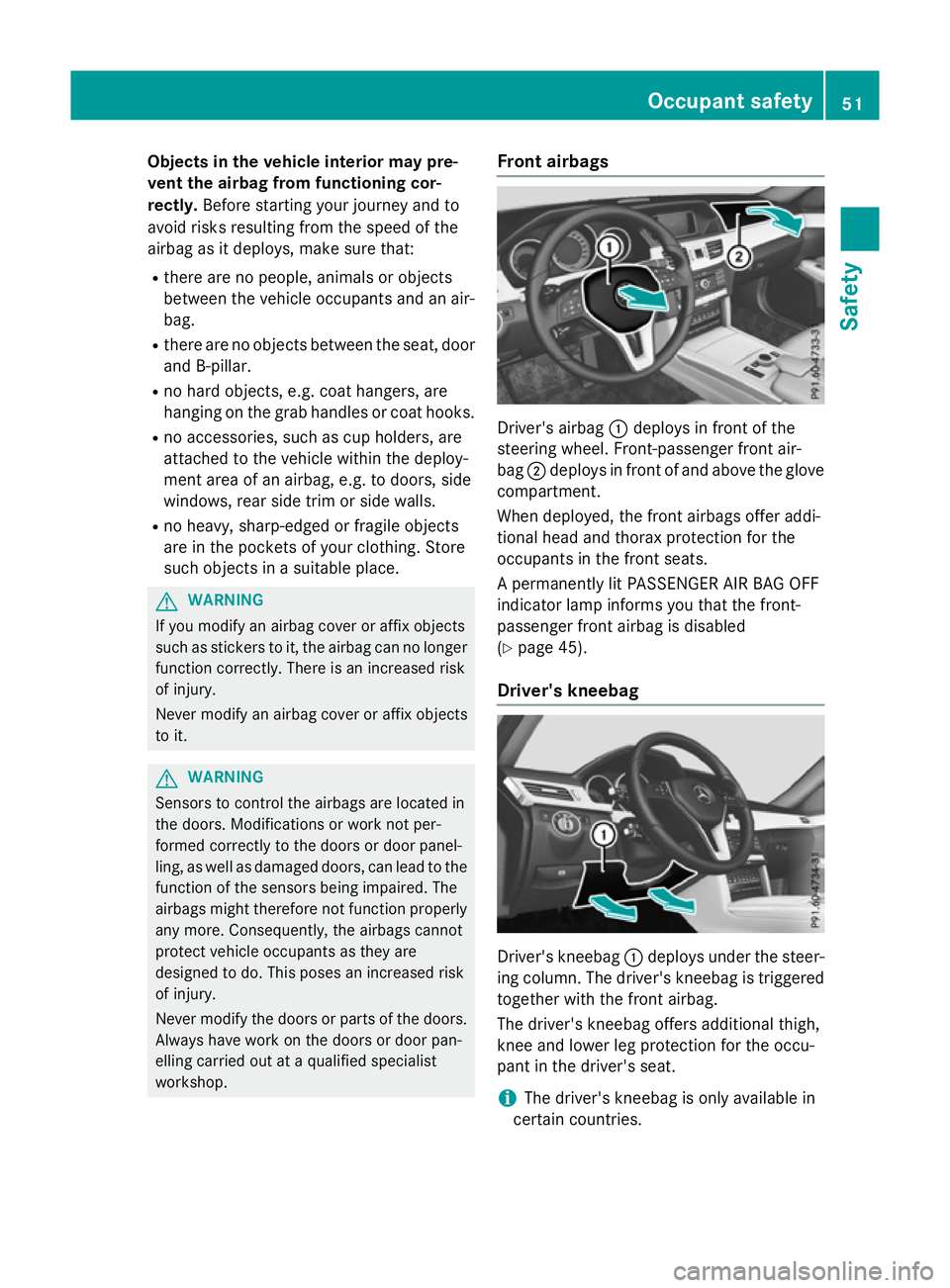
Objects in the vehicle interior may pre-
vent the airba gfrom functioning cor-
rectly. Beforestarting your journey and to
avoid risks resulting from the speed of the
airbag as it deploys, make sure that:
R there are no people, animals or objects
between the vehicle occupant sand an air-
bag.
R there are no objects between the seat, door
and B-pillar.
R no hard objects, e.g. coat hangers, are
hanging on the grab handles or coat hooks.
R no accessories, such as cup holders, are
attached to the vehicle within the deploy-
ment area of an airbag, e.g. to doors, side
windows, rear side trim or side walls.
R no heavy, sharp-edged or fragile objects
are in the pockets of your clothing. Store
such objects in asuitable place. G
WARNING
If you modify an airbag cover or affix objects
such as stickers to it, the airbag can no longer function correctly. There is an increased risk
of injury.
Never modify an airbag cover or affix objects
to it. G
WARNING
Sensors to control the airbags are located in
the doors. Modification sorwork not per-
formed correctly to the doors or door panel-
ling, as well as damaged doors, can lead to the function of the sensor sbeing impaired. The
airbags might therefore not function properly any more. Consequently, the airbags cannot
protec tvehicle occupant sasthey are
designed to do. This poses an increased risk
of injury.
Never modify the doors or parts of the doors.
Always have work on the doors or door pan-
elling carried out at aqualified specialist
workshop. Front airbags
Driver's airbag
:deploys in fron tofthe
steerin gwheel. Front-passenger fron tair-
bag ;deploys in fron tofand above the glove
compartment.
When deployed, the fron tairbags offer addi-
tional head and thorax protection for the
occupant sinthe fron tseats.
Ap ermanently lit PASSENGER AIR BAG OFF
indicator lamp informs you that the front-
passenger fron tairbag is disabled
(Y page 45).
Driver's kneebag Driver's kneebag
:deploys under the steer-
ing column. The driver's kneebag is triggered
together with the fron tairbag.
The driver's kneebag offers additional thigh,
knee and lower leg protection for the occu-
pant in the driver's seat.
i The driver's kneebag is only available in
certain countries. Occupant safety
51Safety Z
Page 55 of 497
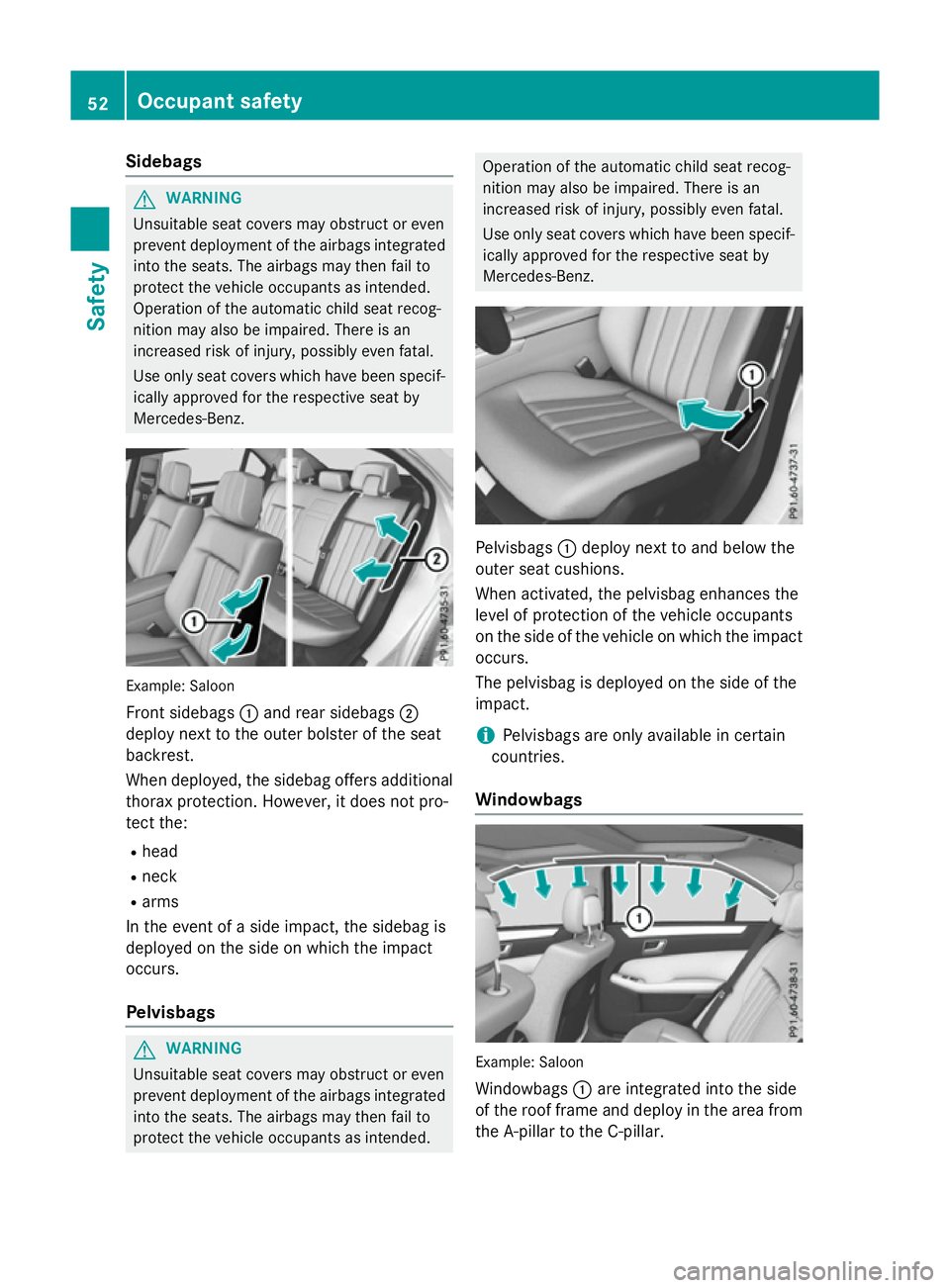
Sidebags
G
WARNING
Unsuitable seat covers may obstruct or even
prevent deployment of the airbags integrated into the seats. The airbags may then fail to
protect the vehicle occupants as intended.
Operation of the automatic child seat recog-
nition may also be impaired. There is an
increased risk of injury, possibly even fatal.
Use only seat covers which have been specif-
ically approved for the respective seat by
Mercedes-Benz. Example: Saloon
Front sidebags :and rear sidebags ;
deploy next to the outer bolster of the seat
backrest.
When deployed, the sidebag offers additional thorax protection. However, it does not pro-
tect the:
R head
R neck
R arms
In the event of aside impact, the sidebag is
deployed on the side on which the impact
occurs.
Pelvisbags G
WARNING
Unsuitable seat covers may obstruct or even
prevent deployment of the airbags integrated into the seats. The airbags may then fail to
protect the vehicle occupants as intended. Operation of the automatic child seat recog-
nition may also be impaired. There is an
increased risk of injury, possibly even fatal.
Use only seat covers which have been specif- ically approved for the respective seat by
Mercedes-Benz. Pelvisbags
:deploy next to and below the
outer seat cushions.
When activated, the pelvisbag enhances the
level of protection of the vehicle occupants
on the side of the vehicle on which the impact
occurs.
The pelvisbag is deployed on the side of the
impact.
i Pelvisbags are only available in certain
countries.
Windowbags Example: Saloon
Windowbags :are integrated into the side
of the roof frame and deploy in the area from the A-pillar to the C-pillar. 52
Occupant safetySafety